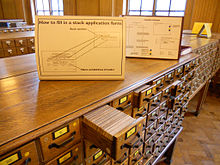
Back Biblioteekkatalogus Afrikaans فهرس مكتبة Arabic Sistemli kataloq Azerbaijani Библиотечен каталог Bulgarian Katalog levraoueg Breton Catàleg de biblioteca Catalan Bibliothekskatalog German Κατάλογος βιβλιοθήκης Greek Biblioteka katalogo Esperanto Catálogo de biblioteca Spanish





A library catalog (or library catalogue in British English) is a register of all bibliographic items found in a library or group of libraries, such as a network of libraries at several locations. A catalog for a group of libraries is also called a union catalog. A bibliographic item can be any information entity (e.g., books, computer files, graphics, realia, cartographic materials, etc.) that is considered library material (e.g., a single novel in an anthology), or a group of library materials (e.g., a trilogy), or linked from the catalog (e.g., a webpage) as far as it is relevant to the catalog and to the users (patrons) of the library.
The earliest library catalogs were lists, handwritten or enscribed on clay tablets and later scrolls of parchment or paper. As codices (books with pages) replaced scrolls, so to did library catalogs become like handwritten ledgers and, in some cases, printed books. During the late 18th century through mid-19th century, cataloguing on paper slips or cards gradually replaced ledgers and books as the main medium for library catalogs, and in the 20th it was long ubiquitous. The card catalog was a familiar sight to library users for generations. Computerized cataloguing developed gradually from the mid-20th, and by the late 20th and early 21st, it had mostly replaced card catalogs. The advent of the web brought about ubiquitous use of online public access catalogs (OPACs). Some people still informally refer to the online catalog as a "card catalog".[2]
The largest international library catalog in the world is the WorldCat union catalog managed by the non-profit library cooperative OCLC.[3] In January 2021, WorldCat had over half a billion catalog records and three billion library holdings.[4]

- ^ Highsmith, Carol M. (2009), Main Reading Room of the Library of Congress in the Thomas Jefferson Building, archived from the original on 2019-06-15, retrieved 2019-04-20
- ^ For example, the website of the Childress Public Library in Childress, Texas refers to its online catalog as a "card catalog": "Online Card Catalog | Childress Public Library". harringtonlc.org. Archived from the original on 2022-10-10. Retrieved 2020-09-17. Another example of the term "card catalog" used to refer to an online catalog is in an instructional presentation produced by the Hayner Public Library District, which serves townships around Alton, Illinois: Cordes, Mary. "Searching the Card Catalog and Managing Your Library Account Online" (PDF). www.haynerlibrary.org. Archived from the original (PDF) on 2022-10-07. Retrieved 2020-09-17.
- ^ Oswald, Godfrey (2017). "Largest unified international library catalog". Library world records (3rd ed.). Jefferson, NC: McFarland & Company. p. 291. ISBN 9781476667775. OCLC 959650095.
- ^ "Inside WorldCat". OCLC. Archived from the original on 2017-01-30. Retrieved 2021-03-09.